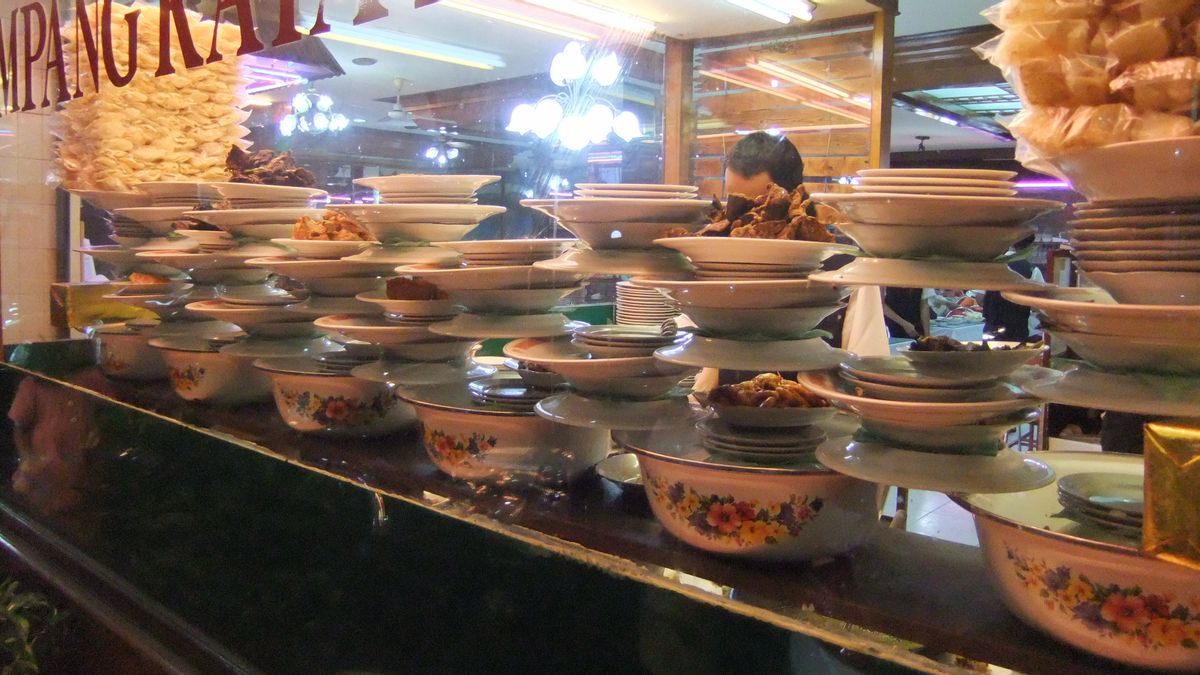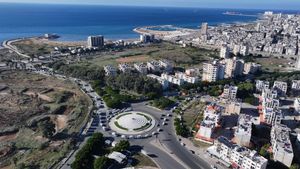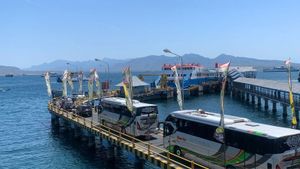JAKARTA - The popularity of Padang rice is supported by the emergence of Padang restaurants. For Minang people, Padang restaurants are not just a place to find sustenance but a means of transmitting noble values. There is a question that may be familiar to the heads of Padang rice lovers. Why does Nasi Padang wrapped in more rice, while if you eat it in a place, the portion of rice is less. We explore the historical aspects behind this culture.
The 19th century was the beginning of the fame of Nasi Padang. This existence is supported by the city of Padang which has become the center of economic activity in West Sumatra. The effect is widespread. All produce in West Sumatra is collected in Padang. Likewise with all basic needs. The field is the gateway.
The Colonial Government then took the initiative to build facilities and infrastructure to support shipments to and from Padang. Roads are the main ones for the smooth mobility of transportation facilities that carry agricultural products, such as horse-drawn carriages and wagons. Therefore, resting places for officials and traders were also built at each strategic point.
In that place the horse can rest for a while. The facilities are quite complete for its time. A rice shop also appeared and became popular with them. In the language of the Minangkabau people, the rice shop is also called lapau nasi, los lambuang, or karan. The term was even more attached long before the popularity of the name RM Padang.

Senior historian and journalist, Rosihan Anwar agrees with this. When he retraced his childhood in Minang land, the term lapau nasi touched his memory again. "Not far from there is a lapau. Since it was midday, we went in to eat nasi padang. Then the lapau gets busier."
"People who just finished Friday prayers at the mosque came to eat according to custom. Our family sat on a row of benches near the corner. The local people sat in another part. They didn't say hello, maybe they saw us from outside and dang-dangung," said Rosihan Anwar. in the book History of Little "Petite Histoire" Indonesia Volume 4 (2010).
Roshan is right. In Minang people's memory, the word lapau nasi is actually more popular than Padang restaurants. The presence of lapau is considered a pioneer. The term lasted until Indonesia's independence. The new changes were obtained after the rebellion emerged from the Revolutionary Government of the Republic of Indonesia (PRRI) in West Sumatra.
After the uprising ended in 1961, all elements of the PRRI were wiped out by the Indonesian government. As revealed by the Minangkabau historian from Andalas University, Gusti Adnan's actions by the government actually sparked a massive exodus of the Minangkabau tribe out of town, including to the island of Java. The exodus became a way of expanding Minang's taste. Padang restaurants continue to grow throughout the country.
"The Padang people after PRRI [the incident] were told to report, told to do this, they say they lost, humiliated, and became prisoners in their own area. Eventually they came out," said Gusti Asnan, quoted by the BBC.
The culture of wandering the Minang peopleThe expansion of Padang restaurants outside the region is not only due to the exodus. Another strong factor is the culture of wandering Minang children. The desire to become an immigrant always accompanies the Minang people's life journey when they grow up. The tradition is lasting because wandering is one of the proofs that the Minang people have grown up.
They must be forged experience, including entrepreneurship in other areas. The thing to note, often wander not because they feel deprived. Their parents can actually provide for all the needs of their children. However, the factor behind them wandering is shame.
“It was a feeling of shame that pushed them to leave the village. If they were constantly in the village, even if everything was sufficient, the girls' mothers and fathers would not pick them up. This is not only embarrassing for the young man himself, but even more so for his mother, mamak, and father. The three of them are very embarrassed when a young man the same age as his child has married and his child has not."
"It's as if the child is not selling well. No matter how much noble blood flows throughout his body, or no matter how much religious knowledge is in his head, as long as they live in the village, the mothers and fathers of the girls prefer to pick up young men who trade in the overseas," said Muhamad Radjab in his autobiography During Childhood in Kampung 1913 -1928 (2019).

Minang children who choose to migrate are not all immediately successful. Many start from the ground up. Some become horsemen to small traders. Thanks to their craft, accuracy, and intelligence, they were finally able to open their own business. Including building their own Padang restaurant outside the area.
Anthropologist from Makassar State University, Dimas Ario Supick, even said that overseas and pioneering activities for the glory of Padang restaurants were not only in Indonesia. They are also scattered in various countries. After all, every person who wanders is often equipped with the ability to manage food with an authentic Minangkabau taste and is typical of the archipelago. This ability is the key to Nasi Padang being favored by various ethnic groups and nations.
“There is a 'merantau' culture that has a deep philosophy for the Minangkabau community, in particular. Migrating is a human activity that is characterized by wandering outside of their area (comfort zone) to develop themselves and improve their standard of living.”
“Meantau in the overseas lands is inherent in the traditions of the Minangkabau people. This is a cultural capital for business development and entrepreneurship. Minang people, I think, deserve to be called the best fighters in the business world, which can be seen by their hard work in establishing Padang Restaurants in various parts of the country," said Dimas Ario Suelek when contacted by VOI, Wednesday, September 8.
Why is there more rice in the wrapped nasi padang?
The phenomenon of exaggerating the portion of rice when it is wrapped in a Padang restaurant is not a new thing. This tradition has been around for a long time. Dimas Ario Supick said there was no single, specific reason related to the tradition of exaggerating the portion. Many versions. There are those who reveal that the tradition of jumbo portions was started as a form of solidarity among the Bumiputras during the Dutch colonial period.
There are also those who reveal as a form of appreciation to customers. From rice wrapped the work of the tavern owner to less. There is no need to wash dishes or eat places. As a form of appreciation, the portion of rice is increased. Finally, exaggerating the portion implies the shop owner's sharing spirit so that rice can be consumed with other family members at home.
This version is also explained by Ade Putri Paramadita, culinary storyteller. "I don't know this. I've heard from some Sumatran people, they say that usually when they bring rice to their house, they usually give them more rice so that they can share their food later. I don't know if it's true or not, but I got this story from some are native to Minang," he told VOI, Wednesday, September 8.
However, from the existing reasons, everything will lead to the intention of the Minang people in preserving noble values such as the spirit of sharing and respecting others that has been inherited from generation to generation. The spirit of sharing and appreciating is like an embodiment of the good values of Islam that have been embraced by the Minang people from the beginning.
"Besides carrying the image of the archipelago taste, Minangkabau cuisine (Nasi Padang) is also attached to the image of an Islamic taste. We know that the Minangkabau people have an identity that shows the collaboration of customs and teachings of Islam. Padang cuisine (so medium). Padang cuisine is also generally accepted because the menu can be categorized using halal ingredients and is served in a halal manner, “concluded Dimas Ario Suelek.
*Read other information about CULINARY or read other interesting articles from Detha Arya Tifada.
Other MEMORIESThe English, Chinese, Japanese, Arabic, and French versions are automatically generated by the AI. So there may still be inaccuracies in translating, please always see Indonesian as our main language. (system supported by DigitalSiber.id)









